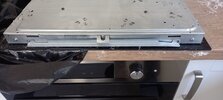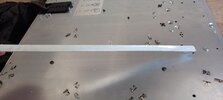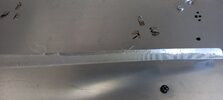Hi all,
Just had a new kitchen fitted.
I noticed that the ceramic hob unit, installed into the counter top above the integral oven, didn't seem to have any seal around it. I asked the fitter what happens if a pan overflows and water goes under the hob unit? He said he would put sealant under it where it makes contact with the counter, and I had no reason in that moment to question this, since he is an experienced professional. Afterwards I asked if this is ok in terms of the heat that will be generated and he said it is better than the foam gasket you usually get with these appliances...
I haven't yet used the cooker at all, since the job was finished the other day, but earlier today found a roll of foam gasket in the lounge, obviously intended for the hob, with a manufacturer's note saying it must be used. I then checked the instruction manual and found this repeated and also an advisory not to use silicone sealant...
Whether this is for safety reasons I don't know, but for one thing, silicone means the hob unit cannot be removed for servicing and the warantee will no doubt now be void before I've even used it.
I've just removed the hob unit, having painstakingly managed to break the sealant with a library card all the way round. My plan was to get the sealant off the counter and underneath of the hob unit and then put the gasket on. Unfortunately, the sealant is proving to be a nightmare to get off the hob unit.
Any advice on how to proceed? Is sealant a safety hazard in that situation? Ideas on how to get it all off? I've contacted the fitter to raise my concerns but part of me doesn't want him back here. I'm thinking he ought to buy a new hob unit rather than try to work his "magic" on it. Am I being unreasonable?
Just had a new kitchen fitted.
I noticed that the ceramic hob unit, installed into the counter top above the integral oven, didn't seem to have any seal around it. I asked the fitter what happens if a pan overflows and water goes under the hob unit? He said he would put sealant under it where it makes contact with the counter, and I had no reason in that moment to question this, since he is an experienced professional. Afterwards I asked if this is ok in terms of the heat that will be generated and he said it is better than the foam gasket you usually get with these appliances...
I haven't yet used the cooker at all, since the job was finished the other day, but earlier today found a roll of foam gasket in the lounge, obviously intended for the hob, with a manufacturer's note saying it must be used. I then checked the instruction manual and found this repeated and also an advisory not to use silicone sealant...
Whether this is for safety reasons I don't know, but for one thing, silicone means the hob unit cannot be removed for servicing and the warantee will no doubt now be void before I've even used it.
I've just removed the hob unit, having painstakingly managed to break the sealant with a library card all the way round. My plan was to get the sealant off the counter and underneath of the hob unit and then put the gasket on. Unfortunately, the sealant is proving to be a nightmare to get off the hob unit.
Any advice on how to proceed? Is sealant a safety hazard in that situation? Ideas on how to get it all off? I've contacted the fitter to raise my concerns but part of me doesn't want him back here. I'm thinking he ought to buy a new hob unit rather than try to work his "magic" on it. Am I being unreasonable?




